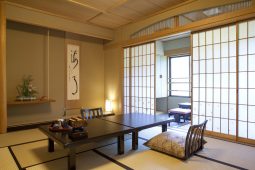Prior to living in Japan, I had a rather hazy image of it as an exotic land with a sultry climate. Summer in Japan is indeed hot and humid, but unless you live on the southernmost subtropical islands of Okinawa, you will find that Japanese winters are very, very cold. And unless you live on the northernmost island of Hokkaido (where having an effective heating system is a matter of survival), you are likely to spend your first winter in Japan perplexed and bemused at how cold it is inside your apartment. Despite Japan’s many modern conveniences, central heating and proper insulation have never really caught on here, and draughty buildings with inadequate heating are the norm. There is however, a traditional item of Japanese furniture that provides an ingenious solution to this problem. Rather than heating an entire apartment or room, you can simply heat the area where you are sitting. This life-saving item of equipment is called a kotatsu.
A kotatsu is a heated table with several parts. It consists of a low table frame with an electric heater fitted underneath, over which goes a heavy floor-length quilt or blanket which retains the heat, and the table top which goes on top of that. In a traditional Japanese room, one sits on the tatami-matted floor with one’s legs under the table and lower body covered by the quilt.
The name kotatsu is written with two characters: the Chinese character 炬 meaning “fire” or “torch” and an original Japanese character 燵 meaning “foot warmer”. However, because these characters are not so common the word 炬燵 is very often written in plain hiragana as こたつ. This cozy little foot-warming device dates back to the 14th century when the main source of heat in a Japanese home was a sunken cooking hearth called an irori. At this time a wooden frame was added to the hearth, and a futon quilt placed over the top. Portable kotatsu were created in the 17th century with the use of a hibachi pot to hold the burning charcoal instead of a hearth and a table with a quilt over the top. This type of kotatsu is called an okigotatsu (置炬燵 — literally “placed kotatsu”) because it was not restricted to one location in the home. Another type of kotatsu, that you will often find today in Japanese restaurants, is placed over a hole in the floor and is called a horigotatsu (掘り炬燵 — literally “hollow kotatsu”). Foreigners who aren’t used to sitting on the floor tend to prefer these horikotatsu, because the hole in which they can dangle their legs is about the same depth as the height of a chair. Interestingly, the horigotatsu was actually developed in the early 20th century by the British potter Bernard Leach for his own home in Tokyo, because he was a tall man who found sitting on the floor uncomfortable. Another 20th-century invention was the denkikotatsu (電気炬燵 “electric kotatsu”) which uses an electric kotatsu heater instead of burning charcoal in a pot. These electric devices first became popular in the 1950 s and as they obviously present less of a fire risk they are now a common feature in many Japanese homes.
It is worth noting in passing that this old-school heating technology is not entirely unique to Japan. In an interesting example of parallel evolution there are similar heated tables in Spain (where they are called brasero), Afghanistan (where they are called sandali), and Iran (where they are called korsi). However, for most Japanese, sitting at a kotatsu eating mikan oranges and reading a book or watching TV is an evocative image of a typical winter at home. Because they are so warm and comfortable, cats love to curl up under kotatsu and people frequently fall asleep when sitting at them. Another happy aspect of kotatsu is that they foster community. Family or friends gather round this source of heat, to share the warmth along with pleasant conversation, and often a good meal.
What better way to spend a winter night in Japan than enjoying a nabe hot-pot party with your friends while seated under the comfy quilt of a heated kotatsu table?








